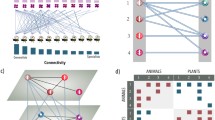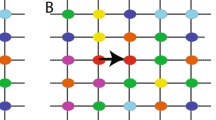Abstract
Mutualistic and antagonistic interactions coexist in nature. However, little is understood about their relative roles and interactive effects on multispecies coexistence. Here, using a three-species population dynamics model of a resource species, its exploiter, and a mutualist species, we show that a mixture of different interaction types may lead to dynamics that differ completely from those of the isolated interacting pairs. More specifically, a combination of globally stable antagonistic and mutualistic subsystems can lead to unstable population oscillations, suggesting the potential difficulty in the coexistence of antagonism and mutualism. Mutualism-induced instability arises from the indirect positive effect of mutualism on the exploiter. Furthermore, for a three-species system with a stronger mutualistic interaction to persist stably, a weaker antagonistic interaction is required. Network studies of communities composed of one type of interaction may not capture the dynamics of natural communities.



Similar content being viewed by others
References
Adler LS (2000) Alkaloid uptake increases fitness in a hemiparasitis plant via reduces herbivory and increasse pollination. Am Nat 156:92–99
Adler LS, Bronstein JL (2004) Attracting antagonists: does floral nectar increase leaf herbivory? Ecology 85:1519–1526
Allesina S, Levine JM (2011) Stability criteria for complex ecosystems. Proc Natl Acad Sci USA 108:5638–5642
Allesina S, Tang S (2012) Stability criteria for complex ecosystems. Nature 483:205–208
Bacher S, Friedli J (2002) Dynamics of mutualism in a multi-species context. Proc R Soc Lond B 269:1517–1522
Bascompte J (2009) Mutualistic networks. Front Ecol Environ 8:429–436
Bascompte J, Jordano P, Merián CJ, Olesen JM (2003) The nested assembly of plant-animal mutualistic networks. Proc Natl Acad Sci USA 100:9383–9387
Boucher DH (1985) The Biology of mutualism: ecology and evolution. Oxford University Press, New York
Bronstein JL, Wilson WG, Morris WF (2003) Ecological dynamics of mutualist/antagonist communities. Am Nat 162:1–20
Fontaine C, Guimarães PR Jr, Kéfi S, Loeuille N, Memmott J, van der Putten WH, van Veen FJF, Thébault E (2011) The ecological and evolutionary implications of merging different types of networks. Ecol Lett 14:1170–1181
Goldberg DE, Barton AM (1992) Patterns and consequences of interspecific competition in natural communities: a review of field experiments with plants. Am Nat 139:771–801
Golinski MR (2006) A review of theoretical approaches for studying the effects of interactions between mutualists and nonmutualists on community stability. Bull Ecol Soc Am 87:37–44
Hairston NG, Smith FE, Slobodkin LB (1960) Community structure, population control, and competition. Am Nat 94:421–425
Herrera CM, Medrano M, Rey PJ, Sánchez-Lafuente AM, García MB, Guitián J, Manzaneda AJ (2002) Interaction of pollinators and herbivores on plant fitness suggests a pathway for correlated evolution of mutualism- and antagonism-related traits. Proc Natl Acad Sci USA 99:16823–16828
Hoeksema JD, Bruna EM (2000) Pursuing the big questions about interspecific mutualism: a review of theoretical approaches. Oecologia 125:321–330
Holland JN, DeAngelis DL, Bronstein JL (2002) Population dynamics and mutualism; functional responses of benefits and costs. Am Nat 159:231–244
Holland JN, Ness JH, Boyle AL, Bronstein JL (2005) Mutualisms as consumer–resource interactions. In: Barbosa P, Castellanos I (eds) Ecology of predator–prey interactions. Oxford University Press, New York, pp 17–33
Huisman J, Weissing FJ (1999) Biodiversity of plankton by species oscillations and chaos. Nature 402:407–410
Irwin RE, Adler LS, Brody AK (2004) The dual role of floral traits: pollinator attraction and plant defense. Ecology 85:1503–1511
Jang SR (2002) Dynamics of herbivore-plant-pollinator models. J Math Biol 44:129–149
Kondoh M (2003) Foraging adaptation and the relationship between food –web complexity and stability. Science 299:1388–1391
Kondoh M (2008) Building trophic modules into a persistent food web. Proc Natl Acad Sci USA 105:16631–16635
Kooi B, Huijper LDJ, Kooijman SALM (2004) Consequences of symbiosis for food web dynamics. J Math Biol 49:227–271
MacArthur R (1970) Species packing and competitive equilibrium for many species. Theor Popul Biol 1:1–11
MacArthur R, Wilson EO (1967) The theory of island biogeography. Princeton University Press, Princeton
Martinez ND, Williams RJ, Dunne JA (2006) Diversity, complexity, and persistence in large model ecosystems. In: Pascual M, Dunne JA (eds) Ecological networks: linking structure to dynamics in food webs. Oxford University Press, Oxford, pp 163–185
May RM (1972) Will a large complex system be stable? Nature 238:413–414
May RM (1974) Stability and complexity in model ecosystems. Princeton University Press, Princeton
May RM (1981) Models of two interacting populations. In: May RM (ed) Theoretical ecology. Sinauer, Sunderland, pp 78–104
McCann K, Hastings A, Huxel GR (1998) Weak trophic interactions and the balance of nature. Nature 395:794–798
Melián CJ, Bascompte J, Jordano P, Krivan V (2009) Diversity in a complex ecological network with two interaction types. Oikos 118:122–130
Morris WF, Bronstein JL, Wilson WG (2003) Three-way coexistence in obligate mutualist–exploiter interactions: the potential role for of competition. Am Nat 161:860–875
Mougi A, Kondoh M (2012) Diversity of interaction types and ecological community stability. Science 337:349–351
Murdoch W, Briggs C, Nisbet R (2003) Consumer-resource dynamics. Princeton University Press, Princeton
Okuyama T, Holland JN (2008) Network structural properties mediate the stability of mutualistic communities. Ecol Lett 11:208–216
Otto SB, Rall BC, Brose U (2007) Allometric degree distributions facilitate food-web stability. Nature 450:1226–1230
Ringel MS, Hu HH, Anderson G (1996) The stability and persistence of mutualisms embedede in community interactions. Theor Popul Biol 50:281–297
Rosenzweig ML (1971) Paradox of enrichment: destabilization of exploitation ecosystems in ecological time. Science 171:385–387
Rozdilsky ID, Stone L (2001) Complexity can enhance stability in competitive systems. Ecol Lett 4:397–400
Schultz JC, Baldwin IT (1982) Oak leaf quality declines in response to defoliation by gypsy moth larvae. Science 217:149–151
Smith DC, Douglas AE (1987) The biology of symbiosis. Edward Arnold, London
Smith HL, Waltman P (1995) The theory of the chemostat. Cambridge University Press, Cambridge
Stouffer DB, Bascompte J (2009) Understanding food-web persistence from local to global scales. Ecol Lett 13:154–161
Thompson JN (2005) The geographic mosaic of coevolution. University of Chicago Prss, Chicago
Thompson AR, Nisbet RM, Schmitt RJ (2006) Dynamics of mutualist populations that are demographically open. J Anim Ecol 75:1239–1251
Wilson WG, Morris WF, Bronstein JL (2003) Coexistence of mutualists and exploiters on spatial landscapes. Ecol Monogr 73:397–413
Wright DH (1989) A simple, stable model of mutualism incorporating handling time. Am Nat 134:664–667
Acknowledgments
This study was supported by the Environment Research and Technology Development Fund (D-1102) of the Ministry of the Environment, Japan, by a Grant-in-Aid for Scientific Research (B) (#20370009), by a Grant-in-Aid for Young Scientists (B) (#25840164), and by a Grant-in-Aid for Challenging Exploratory Research (#23657019) from the Japan Society for the Promotion of Science.
Author information
Authors and Affiliations
Corresponding author
Additional information
Akihoko Mougi is the recipient of the 6th Population Ecology Young Scientist Award.
Electronic supplementary material
Below is the link to the electronic supplementary material.
Rights and permissions
About this article
Cite this article
Mougi, A., Kondoh, M. Instability of a hybrid module of antagonistic and mutualistic interactions. Popul Ecol 56, 257–263 (2014). https://doi.org/10.1007/s10144-014-0430-9
Received:
Accepted:
Published:
Issue Date:
DOI: https://doi.org/10.1007/s10144-014-0430-9




